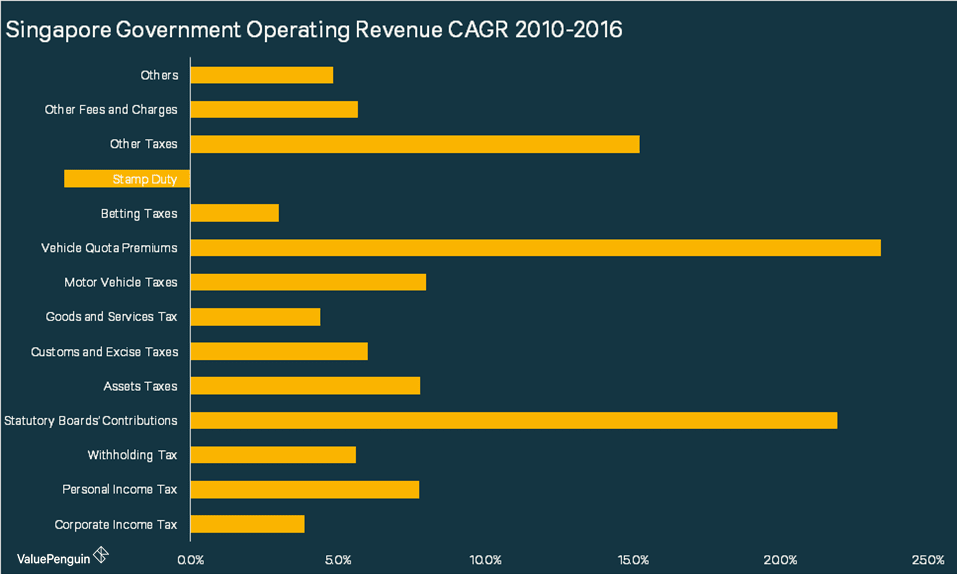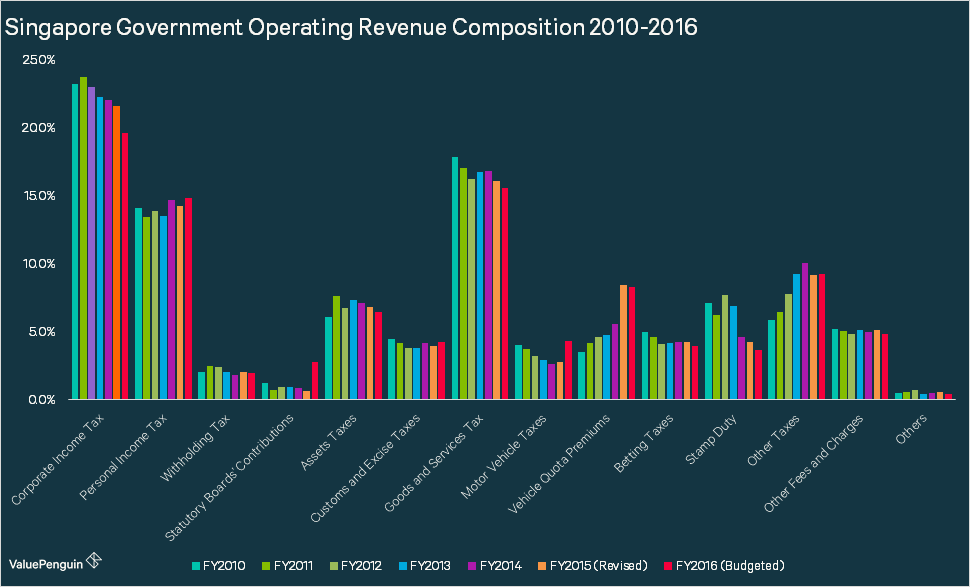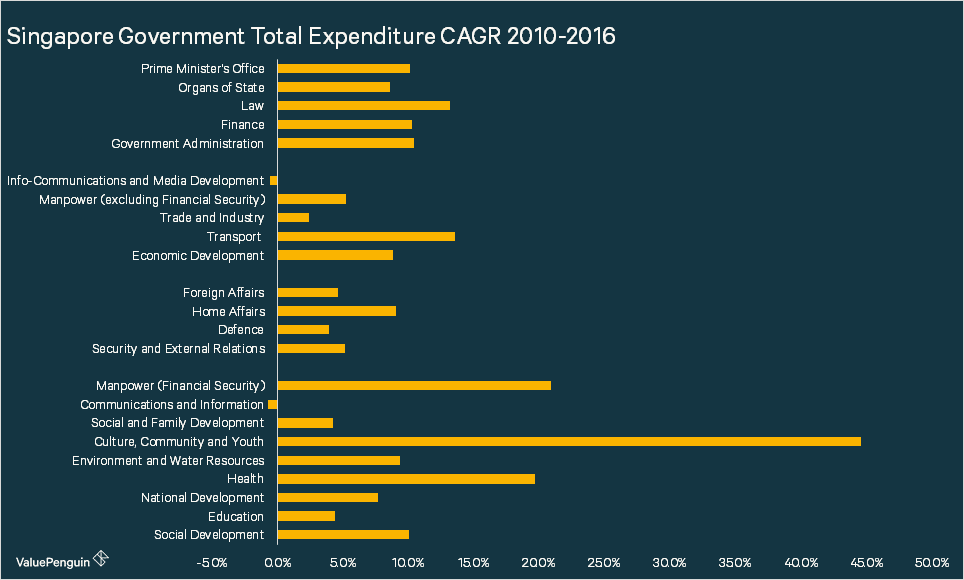The government of Singapore is set to announce its budget plans for 2017 on Monday, 20 Feb 2017. While media is already buzzing about what we could expect to hear from Minister Heng Sweet Keat next week, few have covered what actually has been happening with the government spending for the last few years. Often, we can glean valuable insights for the future by looking back into the past. Here, we attempt to distill a few major trends we observed about the government’s budget since 2010, and assess what it could possible mean for what’s in store for the next few years.
Government Revenue Is Becoming More Dependent On Consumers, Not Companies
The Singapore government’s budget has been becoming more reliant on taxes on consumers rather than on companies. From 2010 to 2016, the government’s operating revenue has increased by about 6.8% per year from S$46bn to S$68bn, while various taxes on consumers have grown at a faster pace. For instance, personal income tax has grown at 7.8% per year, motor vehicle taxes and vehicle quota premiums have grown at 16.5% per year, and other taxes (including water conservation tax, foreign worker levy, development charge and annual tonnage tax) have grown at 15.2% per year. In the meantime, corporate income tax has grown at a slower pace of 3.9% per year.

This implies that corporate income tax has gone from being 23% of government revenue in 2010 to 20% in 2016, while the aforementioned 3 categories have gone from 27.4% of government revenue in 2010 to 36.6% in 2017. This may be a result of the government’s attempt to help businesses stay profitable or operational in face of stagnating economy. Such a move may have helped in reducing unemployment by keeping more companies afloat, meaning that the unemployment rate that has been rising recently could have been higher otherwise.

Government Expenditure Increasingly Focused on Development & Social Safety, but Not Education & Technology
Overall, the Singaporean government’s expenditure has increased by about 8.4% per year since 2010 to 2016 from S$45bn to S$73bn, slightly faster than its revenue growth rate of 6.8%. The main drivers of this growth has been social development (10.1% per year) and health development (19.7% per year).

Essentially, the government has been shifting money away from security & external relations in order to invest in its social and economic infrastructures since 2010. For instance, security and external relations represented 32.3% of government’s budget in 2010. By 2016, this portion had declined to 27%. This decline was almost entirely offset by social development, whose proportion increased from 44.3% in 2010 to 48.7% in 2016.

What’s particularly interesting about this growth in social development expenditure is how the government has increased its spending massively for health from 8.3% in 2010 of budget to 15% of budget in 2016. This reflects the ageing population in Singapore, and the government’s conscious effort to provide necessary care for the elderly. However, the government has also decreased the portion of its budget going into education, which grew by only 4.4% per year and represents 17.4% of its budget in 2016 compared to 21.8% in 2010.

The government of Singapore continues to invest in its infrastructure to create jobs. From 2010 to 2016, economic development expenditure grew by 8.9% per year, of which investment in transport grew at the quickest pace at 13.6% per year. Transport was the 4th biggest spending area for the government in 2016, representing about 13.8% of total budget in 2016 compared to 10.4% in 2010. In contrast, economic development expense in info-communications and media development actually declined by -0.6% per year.

What Could We Expect from 2017?
While our team at ValuePenguin tend to stay away from making bold predictions without substantial data and evidence, there are a few things that we hope to see in the upcoming budget announcement. First, we would like to see the government increase their expenditures & deficit in order to invest more heavily into long-term growth initiatives. The Singapore government has run a large surplus for a long time, and it could definitely afford some deficit for the foreseeable future. This could come in form of continued investment into its infrastructure, as well as various tax reduction initiatives for corporates. It may be wise for them to even consider a meaningful tax cut for the consumers, which could have a positive impact on consumption and therefore the economy, and represented not even 1% of total expenditure for the government.
| S$ mn | FY2010 | FY2011 | FY2012 | FY2013 | FY2014 | FY2015 (Revised) | FY2016 (Budgeted) |
|---|---|---|---|---|---|---|---|
| S$ mn Primary Surplus / (Deficit) | FY2010 722 | FY2011 4,514 | FY2012 6,811 | FY2013 5,292 | FY2014 4,190 | FY2015 (Revised) (4,246) | FY2016 (Budgeted) (4,986) |
| S$ mn Basic Surplus / (Deficit) | FY2010 (782) | FY2011 1,605 | FY2012 5,353 | FY2013 2,303 | FY2014 334 | FY2015 (Revised) (8,783) | FY2016 (Budgeted) (7,655) |
| S$ mn Overall Budget Surplus / (Deficit) | FY2010 980 | FY2011 4,003 | FY2012 5,821 | FY2013 4,998 | FY2014 571 | FY2015 (Revised) (4,884) | FY2016 (Budgeted) 3,450 |
Secondly, we would like to see some increased investment in areas like education and technology. As you can see in our chart in the previous section, government’s development expenditure on education has declined from 22% of total spend in 2010 to 17% in 2016. At the same time, social & economic development expenditure on media, information and communication has fallen from 2.7% in 2010 to mere 1.6% in 2016. Education and technology are crucial in driving an economy’s long term growth by upgrading the country’s talent level. Given the government’s recent interest in developing a booming hub for startups and technology companies, we are hopeful that the budget announcement may contain some increased investment in this area.
The article What We Can Learn from Singapore Government’s Budgets for the last 7 Years originally appeared on ValuePenguin.
ValuePenguin helps you find the most relevant information to optimise your personal finances. Like us on our Facebook page to keep up to date with our latest news and articles.
More From ValuePenguin:
- Snapchat’s Download Ranking Declines while Instagram’s Rises Globally
- Credit Card Rewards in Singapore Are Getting Worse
- Best Home Loans 2017
Source: ValuePen

